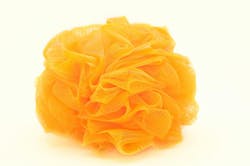Loofah-inspired hydrogel purifies water even when it’s cloudy
The American Chemical Society has reported that research in ACS Central Science made a loofah-inspired hydrogel that could potentially purify enough water for a person’s daily needs, even when its cloudy.
Previously, researchers have suggested that sunlight-driven evaporation could be a low-energy way to purify water through hydrogels. However, this approach doesn’t work well when it’s cloudy.
One solution could be temperature-responsive hydrogels, specifically poly(N-isopropyl acrylamide) (PNIPAm), that switch from absorbing water at cooler temperatures to repelling it when heated. However, conventional PNIPAm gels can’t generate clean water fast enough to meet people’s daily needs because of their closed-off pores. Conversely, natural loofahs, which many people use to exfoliate in the shower, have large, open and interconnected pores.
The researchers used a water and ethylene glycol mixture as a uniquely different polymerization medium to make a PNIPAm hydrogel with an open pore structure, similar to a natural loofah. Then they coated the opaque hydrogel’s inner pores with polydopamine (PDA) and poly(sulfobetaine methacrylate) (PSMBA), and tested this material using an artificial light equivalent to the power of the sun.
The new hydrogel absorbed water at room temperature and, when heated by the artificial light, released 70% of its stored water in 10 minutes. The researchers say that, at this rate, the material has the potential to meet a person’s daily demand. And under lower light conditions, replicating partly cloudy skies, it took 15 to 20 minutes for the material to release a similar amount of stored water.
Finally, the new loofah-like material was tested on samples polluted with organic dyes, heavy metals, oil and microplastics. In all of the tests, the gel made the water substantially cleaner. For example, in two cycles of treatment, water samples with around 40 parts per million (ppm) chromium were absorbed, then released with less than 0.07 ppm chromium — the allowable limit for drinking water. The researchers say the unique hydrogel structure that they created could be useful in additional applications, such as drug delivery, smart sensors and chemical separations.
The authors acknowledge funding from a Princeton University Presidential Postdoctoral Fellowship, a National GEM Consortium Fellowship, the U.S. National Science Foundation, the Eric and Wendy Schmidt Transformative Technology Fund at Princeton University, the Project X Fund at Princeton University and the Princeton Catalysis Initiative.
